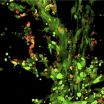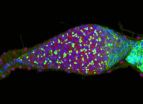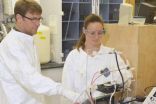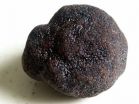(Press-News.org) ANN ARBOR, Mich. — Brain tumors fly under the radar of the body's defense forces by coating their cells with extra amounts of a specific protein, new research shows.
Like a stealth fighter jet, the coating means the cells evade detection by the early-warning immune system that should detect and kill them. The stealth approach lets the tumors hide until it's too late for the body to defeat them.
The findings, made in mice and rats, show the key role of a protein called galectin-1 in some of the most dangerous brain tumors, called high grade malignant gliomas. A research team from the University of Michigan Medical School made the discovery and has published it online in the journal Cancer Research.
In a stunning example of scientific serendipity, the team uncovered galectin-1's role by pursuing a chance finding. They had actually been trying to study how the extra production of galectin-1 by tumor cells affects cancer's ability to grow and spread in the brain.
Instead, they found that when they blocked cancer cells from making galectin-1, the tumors were eradicated; they did not grow at all. That's because the "first responders" of the body's immune system – called natural killer or NK cells – spotted the tumor cells almost immediately and killed them.
But when the tumor cells made their usual amounts of galectin-1, the immune cells couldn't recognize the cancerous cells as dangerous. That meant that the immune system couldn't trigger the body's "second line of defense", called T cells – until the tumors had grown too large for the body to beat.
Team leader Pedro Lowenstein, M.D., Ph.D, of the U-M Department of Neurosurgery, says the findings open the door to research on the effect of blocking galectin-1 in patients with gliomas.
"This is an incredibly novel and exciting development, and shows that in science we must always be open-minded and go where the science takes us; no matter where we thought we wanted to go," says Lowenstein, whose graduate student Gregory J. Baker is the first author of the paper.
"In this case, we found that over-expression of galectin-1 inhibits the innate immune system, and this allows the tumor to grow enough to evade any possible effective T cell response," he explains. "By the time it's detected, the battle is already lost."
The NK-evading "stealth" function of the extra-thick coating of galectin-1 came as a surprise, because glioma researchers everywhere had assumed the extra protein had more to do with the insidious ability of gliomas to invade the brain, and to evade the attacks of T cells.
Gliomas, which make up about 80 percent of all malignant brain tumors, include anaplastic oligodendrogliomas, anaplastic astrocytomas, and glioblastoma multiforme. More than 24,000 people in the U.S. are diagnosed with a primary malignant brain tumor each year.
The tiny tendrils of tumor that extend into brain tissue from a glioma are what make them so dangerous. Even when a neurosurgeon removes the bulk of the tumor, small invasive areas escape detection and keep growing, unchecked by the body.
Helping the innate immune system to recognize early stages of cancer growth, and sound the alarm for the body's defense system to act while the remaining cancer is still small enough for them to kill, could potentially help patients.
While the new discovery opens the door to that kind of approach, much work needs to be done before the mouse-based research could help human patients, says Lowenstein, who is the Richard Schneider Collegiate Professor in Neurosurgery and also holds an appointment in the U-M Department of Cell and Developmental Biology. Galectin-1 may help other types of tumor evade the innate NK cells, too
The new research suggests that in the brain's unique environment, galectin-1 creates an immunosuppressive effect immediately around tumor cells. The brain cancer cells seem to have evolved the ability to express their galectin-1 genes far more than normal, to allow the tumor to keep growing.
Lowenstein and co-team leader Maria Castro, Ph.D., have long studied the immune system's interactions with brain cancer, using funding from the National Institutes of Health, and are co-leading a new clinical trial for malignant glioma (NCT01811992), that aims to translate prior research achievements into new trials for patients with brain tumors.
Most brain tumor immune research has focused on triggering the action of the adaptive immune system – whose cells control the process that allows the body to kill invaders from outside or within.
But that system take days or even weeks to reach full force – enough time for incipient tumors to grow too large for immune cells to eliminate solid tumor growth. The new research suggests the importance of enhancing the ability of the innate immune system's "early warning" sentinels to spot glioma cells as early as possible.
INFORMATION:
Lowenstein, Castro, and Baker worked with U-M Cell & Developmental Biology and Biomedical Engineering researcher Sivaraj Sivaramakrishnan, Ph.D., on the new research. Co-authors are Peter Chockley, Viveka Nand Yadav, Ph.D., Robert Doherty and Michael Ritt.
The research was supported by the National Institute of Neurological Disorders & Stroke (NS054193, NS061107, NS082311, NS052465, NS057711, NS074387).
Reference: Cancer Research, OnlineFirst, doi:10.1158/0008-5472.CAN-14-1203, http://cancerres.aacrjournals.org/content/early/2014/07/18/0008-5472.CAN-14-1203.abstract
For patients: The U-M Neurooncology Program, part of the U-M Comprehensive Cancer Center, treats patients with all forms of brain cancer. For information on U-M clinical care and clinical trials for brain tumors, visit http://umhealth.me/btprogram or call 1-800-865-1125. END
Brain tumors fly under the body's radar like stealth jets, new U-M research suggests
Extra protein on surface of early-stage glioma cells evades immune response
2014-08-06
ELSE PRESS RELEASES FROM THIS DATE:
NIST ion duet offers tunable module for quantum simulator
2014-08-06
BOULDER, Colo -- Physicists at the National Institute of Standards and Technology (NIST) have demonstrated a pas de deux of atomic ions that combines the fine choreography of dance with precise individual control.
NIST's ion duet, described in the August 7 issue of Nature, is a component for a flexible quantum simulator that could be scaled up in size and configured to model quantum systems of a complexity that overwhelms traditional computer simulations. Beyond simulation, the duet might also be used to perform logic operations in future quantum computers, or as a quantum-enhanced ...
Stowers researchers reveal molecular competition drives adult stem cells to specialize
2014-08-06
KANSAS CITY, MO — Adult organisms ranging from fruit flies to humans harbor adult stem cells, some of which renew themselves through cell division while others differentiate into the specialized cells needed to replace worn-out or damaged organs and tissues.
Understanding the molecular mechanisms that control the balance between self-renewal and differentiation in adult stem cells is an important foundation for developing therapies to regenerate diseased, injured or aged tissue.
In the current issue of the journal Nature, scientists at the
Stowers Institute for ...
Enhanced international cooperation needed in Antarctica
2014-08-06
Countries need to work together to ensure Antarctic research continues and key questions on the region are answered, researchers say.
In an article published in Nature this week, 75 scientists along with policy makers in 22 countries have outlined what they see as the major priorities for Antarctic research over the next 20 years and beyond.
In it they outline six priorities for Antarctic science – the most important scientific questions to be addressed in the region, as well as what they think is needed to achieve them.
One of the report's lead authors, Monash University ...
Mercury in the global ocean
2014-08-06
Although the days of odd behavior among hat makers are a thing of the past, the dangers mercury poses to humans and the environment persist today.
Mercury is a naturally occurring element as well as a by-product of such distinctly human enterprises as burning coal and making cement. Estimates of "bioavailable" mercury—forms of the element that can be taken up by animals and humans—play an important role in everything from drafting an international treaty designed to protect humans and the environment from mercury emissions, to establishing public policies behind warnings ...
Farm manager plays leading role in postharvest loss
2014-08-06
URBANA, Ill. – With all the effort it takes to grow a food crop from seed to sale, it may be surprising that some farms in Brazil lose 10 to 12 percent of their yield at various points along the postharvest route. According to a University of Illinois agricultural economist, when it comes to meeting the needs of the world's growing population that's a lot of food falling through the cracks. Interestingly, farm managers who are aware of the factors that contribute to postharvest grain loss actually lose less grain. This was one of the findings in a study that examined how ...
NASA satellite paints a triple hurricane Pacific panorama
2014-08-06
In three passes over the Central and Eastern Pacific Ocean, NASA's Terra satellite took pictures of the three current tropical cyclones, painting a Pacific Tropical Panorama. Terra observed Hurricane Genevieve, Hurricane Iselle and Hurricane Julio in order from west to east. Iselle has now triggered a tropical storm watch in Hawaii.
The Moderate Resolution Imaging Spectroradiometer or MODIS instrument is a key instrument aboard NASA's Terra and Aqua satellites. Between the two satellites, MODIS instruments view the entire surface of the Earth every one to two days. When ...
Most kids with blunt torso trauma can skip the pelvic X-ray
2014-08-06
WASHINGTON – Pelvic x-rays ordered as a matter of course for children who have suffered blunt force trauma do not accurately identify all cases of pelvic fractures or dislocations and are usually unnecessary for patients for whom abdominal/pelvic CT scanning is otherwise planned. A study published online in Annals of Emergency Medicine last week casts doubt on a practice that has been recommended by the Advanced Trauma Life Support Program (ATLS), considered the gold standard for trauma patients "(Sensitivity of Plain Pelvis Radiography in Children with Blunt Torso Trauma). ...
Scientists discover how 'jumping genes' help black truffles adapt to their environment
2014-08-06
Black truffles, also known as Périgord truffles, grow in symbiosis with the roots of oak and hazelnut trees. In the world of haute cuisine, they are expensive and highly prized.
In the world of epigenetics, however, the fungi (Tuber melanosporum) are of major interest for another reason: their unique pattern of DNA methylation, a biochemical process that chemically modifies nucleic acids without changing their sequence. Epigenetics is the study of changes in gene expression caused by mechanisms other than changes in the DNA sequence.
A newly published study in the journal ...
Wiki ranking
2014-08-06
Wikipedia the free, online collaborative encyclopedia is an important source of information. However, while the team of volunteer editors endeavors to maintain high standards, there are occasionally problems with the veracity of content, deliberate vandalism and incomplete entries. Writing in the International Journal of Information Quality, computer scientists in China have devised a software algorithm that can automatically check a particular entry and rank it according to quality.
Jingyu Han and Kejia Chen of Nanjing University of Posts and Telecommunications, explain ...
A new way to model cancer
2014-08-06
CAMBRIDGE, MA -- Sequencing the genomes of tumor cells has revealed thousands of mutations associated with cancer. One way to discover the role of these mutations is to breed a strain of mice that carry the genetic flaw — but breeding such mice is an expensive, time-consuming process.
Now, MIT researchers have found an alternative: They have shown that a gene-editing system called CRISPR can introduce cancer-causing mutations into the livers of adult mice, enabling scientists to screen these mutations much more quickly.
In a study appearing in the August 6th issue of ...
LAST 30 PRESS RELEASES:
Heart-brain connection: international study reveals the role of the vagus nerve in keeping the heart young
Researchers identify Rb1 as a predictive biomarker for a new therapeutic strategy in some breast cancers
Survey reveals ethical gaps slowing AI adoption in pediatric surgery
Stimulant ADHD medications work differently than thought
AI overestimates how smart people are, according to HSE economists
HSE researchers create genome-wide map of quadruplexes
Scientists boost cell "powerhouses" to burn more calories
Automatic label checking: The missing step in making reliable medical AI
Low daily alcohol intake linked to 50% heightened mouth cancer risk in India
American Meteorological Society announces Rick Spinrad as 2026 President-Elect
Biomass-based carbon capture spotlighted in newly released global climate webinar recording
Illuminating invisible nano pollutants: advanced bioimaging tracks the full journey of emerging nanoscale contaminants in living systems
How does age affect recovery from spinal cord injury?
Novel AI tool offers prognosis for patients with head and neck cancer
Fathers’ microplastic exposure tied to their children’s metabolic problems
Research validates laboratory model for studying high-grade serous ovarian cancer
SIR 2026 delivers transformative breakthroughs in minimally invasive medicine to improve patient care
Stem Cell Reports most downloaded papers of 2025 highlight the breadth and impact of stem cell research
Oxford-led study estimates NHS spends around 3% of its primary and secondary care budget on the health impacts of heat and cold in England
A researcher’s long quest leads to a smart composite breakthrough
Urban wild bees act as “microbial sensors” of city health.
New study finds where you live affects recovery after a hip fracture
Forecasting the impact of fully automated vehicle adoption on US road traffic injuries
Alcohol-related hospitalizations from 2016 to 2022
Semaglutide and hospitalizations in patients with obesity and established cardiovascular disease
Researchers ‘listen in’ to embryo-mother interactions during implantation using a culture system replicating the womb lining
How changing your diet could help save the world
How to make AI truly scalable and reliable for real-time traffic assignment?
Beyond fragmented markets: A new framework for efficient and stable ride-pooling
Can shape priors make road perception more reliable for autonomous driving?
[Press-News.org] Brain tumors fly under the body's radar like stealth jets, new U-M research suggestsExtra protein on surface of early-stage glioma cells evades immune response






